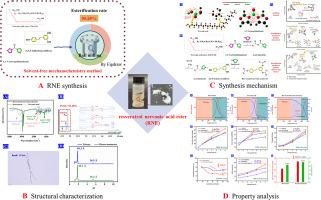无溶剂机械化学法合成新型白藜芦醇神经酸酯:提高亲脂性、热稳定性和氧化稳定性
IF 9.8
1区 农林科学
Q1 CHEMISTRY, APPLIED
引用次数: 0
摘要
白藜芦醇(Resveratrol, RES)是一种具有较强抗氧化性能的多酚,但由于其亲脂性和稳定性较差,在食品工业中的应用受到限制。提出了一种绿色、简单、有效、通用的无溶剂机械化学合成白藜芦醇神经酸酯(RNE)的新方法。RNE的转化率为95.85 %,纯度为91.28 %,收率为80.78 %。醇性脂肪酸酯的收率也很高(94.54 ~ 99.48 %)。RNE的合成机制包括形成一个4 ' -单酯,然后是一个4 ‘,5-二酯,最后是一个3,4 ’,5-三酯。RNE为微黄色固体,由3,4 ',5 ' -三酯(87.19 %),3/5,4 ' -二酯(11.61 %)和4 ' -单酯(1.2 %)组成。与RES相比,RNE的亲脂性(204.08倍)、热稳定性(148.9 °C)和氧化稳定性(1.05-1.60倍)显著提高。本研究为醇性脂肪酸酯的合成提供了新的思路,扩大了RES在食品工业中的应用。本文章由计算机程序翻译,如有差异,请以英文原文为准。


Synthesis of novel resveratrol nervonic acid ester using a solvent-free mechanochemical method: Improved lipophilicity, thermostability, and oxidation stability
Resveratrol (RES), a polyphenol with strong antioxidant properties, has limited applications in the food industry because of its poor lipophilicity and stability. A new, green, simple, effective, and universally applicable approach was presented for synthesizing resveratrol nervonic acid (NA) ester (RNE) using a solvent-free mechanochemical method. The conversion, purity, and yield of RNE reached 95.85 %, 91.28 %, and 80.78 %, respectively. High yields of alcoholic fatty acid esters (94.54–99.48 %) were also achieved. The RNE synthesis mechanism involved the formation of a 4′- monoester, followed by a 4′, 5- diester, and ultimately a 3,4′,5- triester. RNE was a slightly yellowish solid with a composition of 3,4′,5 -triester (87.19 %), 3/5,4′-diester (11.61 %), and 4′-monoester (1.2 %). Compared to RES, RNE exhibited significantly improved lipophilicity (204.08 times), thermostability (148.9 °C), and oxidation stability (1.05–1.60 times). This study provided a novel strategy for the synthesis of alcoholic fatty acid esters, expanding the application of RES in the food industry.
求助全文
通过发布文献求助,成功后即可免费获取论文全文。
去求助
来源期刊

Food Chemistry
工程技术-食品科技
CiteScore
16.30
自引率
10.20%
发文量
3130
审稿时长
122 days
期刊介绍:
Food Chemistry publishes original research papers dealing with the advancement of the chemistry and biochemistry of foods or the analytical methods/ approach used. All papers should focus on the novelty of the research carried out.
 求助内容:
求助内容: 应助结果提醒方式:
应助结果提醒方式:


